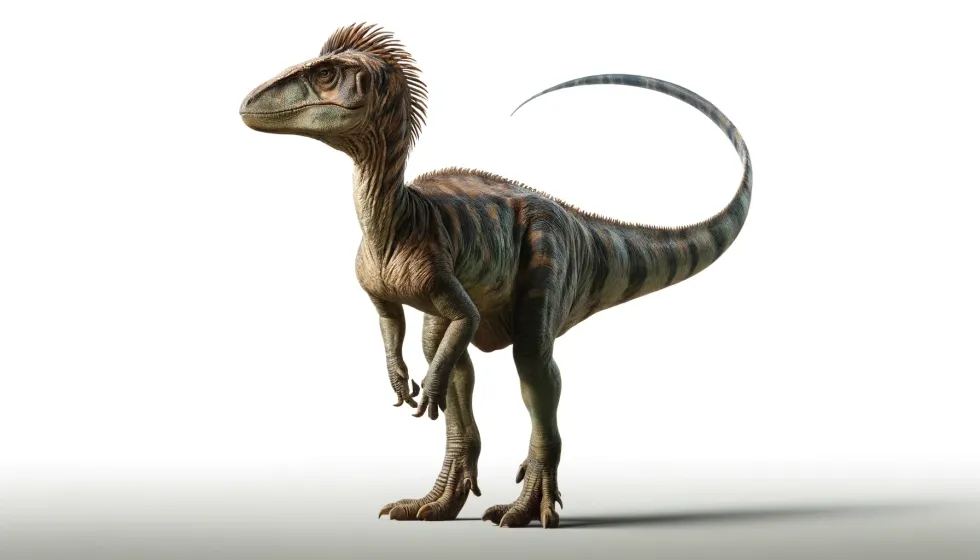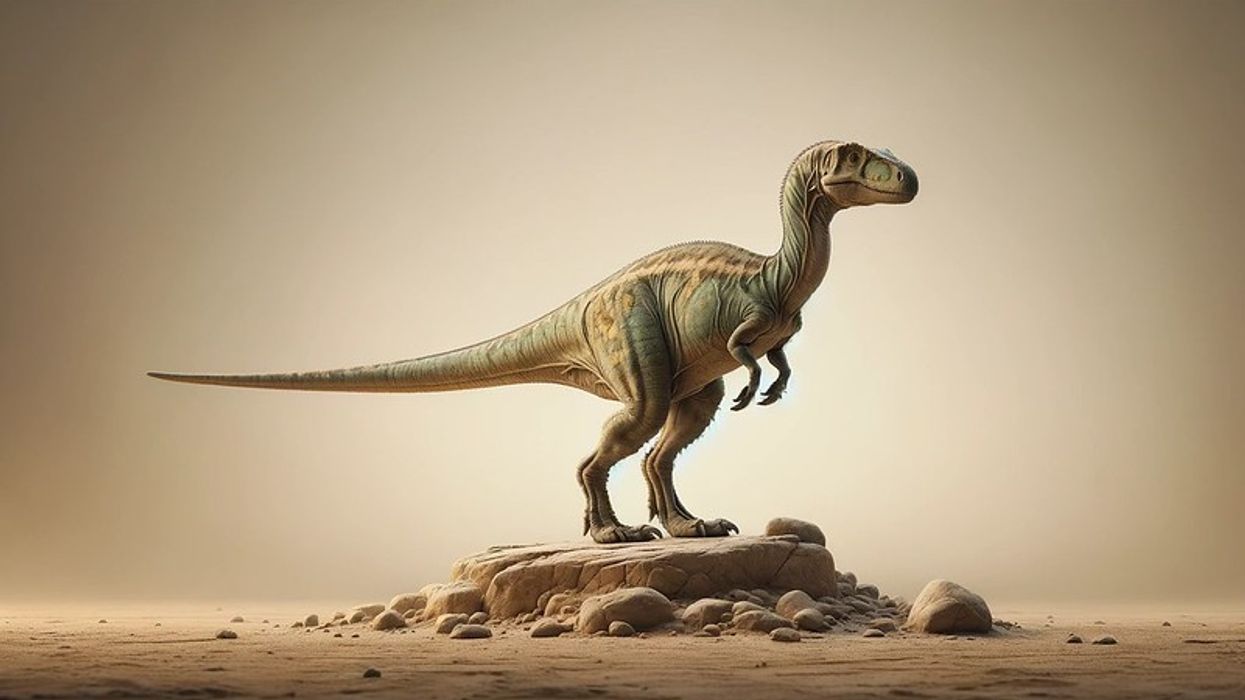With its name meaning 'unknown crest', Adelolophus remains a mysterious dinosaur, admired for its rare position as the possessor of the only known and oldest lambeosaur material from its time. Found in the fossil-rich Grand Staircase-Escalante National Monument, the Adelolophus locality, it shares its origins with numerous other prehistoric animals that resided in the same locality.
Terry Gates and colleagues were the first to identify this distinct genus, noting its unique features. These included a particularly short medial wall alongside a very tall medial wall, which set it apart from its North American relatives.
As the only known species from an ancient wet and possibly marine-influenced habitat, the Adelolophus hutchisoni joins the story of Earth's biodiversity with pages still being filled out.
Adelolophus Interesting Facts
How do you pronounce 'Adelolophus'?
It's pronounced as 'A-deh-loh-fus'.
What type of dinosaur was it?

It belonged to the lambeosaurine hadrosaurids, a subset of hadrosaurs recognized by their notable crested heads.
In which geological period did this dinosaur roam the Earth?
It lived around 83.5-70.6 million years ago during the Campanian stage (83.6-72.1 million years ago) of the Late Cretaceous Period (100.5-66 million years ago).
When did the Adelolophus become extinct?
It lived in the Late Cretaceous during the Campanian stage and probably went extinct in the Cretaceous-Paleogene (K-Pg) extinction event about 66 million years ago, just like other non-avian dinosaurs.
However, without additional fossil evidence, the precise extinction date remains unclear.
Where did this dinosaur live?
It roamed the Earth in the Late Cretaceous Era, during the Campanian stage, in present-day Utah, United States. Fossils of this dinosaur were discovered within the Upper Member of the Wahweap Formation, a sedimentary layer from that time, situated in the southern part of Utah near Lake Powell, inside the boundaries of the Grand Staircase–Escalante National Monument.
What was their habitat?

.
They inhabited freshwater river environments with a generally wet climate and more marine influence in the older Middle Member regions compared to the younger Upper Member areas of its geological formation.
Who did they live with?

Information on the exact social structure of the Adelolophus is not well-recorded, but it possibly coexisted with numerous other animals in its locality.
How long did this dinosaur live?
It is an extinct dinosaur species whose lifespan is not well documented. However, based on its physical characteristics and comparison with related dinosaur species, its lifespan may have been similar to those of its counterparts.
Further research and studies on its fossils and bones may eventually provide more detailed information on the lifespan of this fascinating dinosaur species.
How did they reproduce?

Adelolophus, a genus of hadrosaurid dinosaur that lived during the Late Cretaceous Period, is known to have reproduced by laying eggs, a common trait among ornithischian dinosaurs.
These eggs were typically buried in nests made of vegetation, and the young hatchlings would have emerged from the eggs after a period of incubation.
The size and shape of the eggs and the structure of the nests may have varied depending on the specific species of hadrosaurid.
Overall, the ability to lay eggs and care for their young was an important adaptation that allowed these dinosaurs to reproduce and thrive in their environments successfully.
Adelolophus Fun Facts
What did they look like?
Adelolophus was a hadrosaurid dinosaur of medium to large size, characterized by its unique 'duck-bill' shape, which may have included a possibly hollow crest on its head, specialized features on its face, and modifications suited for eating a diet of rough, plant-based food.
How many bones did an Adelolophus have?

The total bone count for Adelolophus remains uncertain. The species Adelolophus hutchisoni, the sole type and only known species, has been identified from just one fossil fragment, including a fractured maxilla.
How did they communicate?
During the Late Cretaceous Period, Adelolophus, a type of plant-eating dinosaur, probably communicated with their peers using a combination of sounds and body language.
This is similar to how other animals, such as birds and crocodiles, communicated during that time.
Although there is no definite proof to support these theories, ongoing research may provide more information about how they interacted with each other.
How big was the Adelolophus?
The exact size of the Adelolophus is unclear due to limited bone findings. Estimates suggest it measured about 20-27 ft (6-8.2 m) in length, based on the largest specimen discovered.
How fast could this dinosaur move?
There is no definitive evidence regarding the Adelolophus' speed or movement capabilities.
How much did an Adelolophus weigh?
The lambeosaurine Adelolophus hutchisoni is thought to have tipped the scales at around 6,834 lb (3,099 kg).
What were the male and female names of the species?
It's difficult to tell male and female individuals apart because there is no specific naming system. This means that there aren't any physical or behavioral characteristics that can be used to distinguish between the sexes of this species.
More research may be necessary to identify any differences and create a more specific classification system.
What would you call a baby Adelolophus?
When Adelolophus, a genus of herbivorous dinosaur, lays its eggs, the baby dinosaur that hatches from it is called a hatchling. As the hatchling grows, it is referred to as a juvenile.
The juvenile will continue to grow and develop until it reaches adulthood.
How aggressive were they?
There is no direct evidence available to determine its temperament. But based on its diet as a herbivorous dinosaur, it is safe to assume that it was not as aggressive as its carnivorous counterparts, such as the theropods.
While the exact behavior of Adelolophus is uncertain, it is believed to have been a peaceful creature that did not engage in confrontational behavior.
As a herbivore, it would have likely spent most of its time grazing and foraging for food, peacefully coexisting with other plant-eating dinosaurs.
Did You Know…
The fossil-bearing locality where Adelolophus remains were found is in the Death Ridge region in Kane County, Utah. Howard D. Zeller was the first to document this discovery back in 1973, which brought the Adelolophus into the spotlight of paleontological research.
The authors interpreted Adelolophus as the earliest known lambeosaurine from North America, estimated at around 78 million years old. This discovery sheds light on the evolution and distribution of this unique group of dinosaurs that had distinctive crests on their skulls.
In 2021, a study by Nicholas Longrich and colleagues included Adelolophus in a phylogenetic analysis, which tests its relation with other hadrosaurs. The study discovered that Adelolophus belongs to the tribe Parasaurolophini, placing it as a sister taxon to the unusual Tlatolophus.
The remains of many other animals were found in the same location as the holotype of Adelolophus. This gives us an idea of the kind of animals Adelolophus would have lived with.
Adelolophus holds the distinction of possessing the only known lambeosaur material from its time, providing invaluable insights into the diversity and evolution of these crested dinosaurs.
The only known bone, the maxilla, is part of the upper jaw and holds teeth. It belongs to a lambeosaur, a type of dinosaur that had large, hollow head crests. The maxilla has a triangular shape that identifies it as a lambeosaur bone.
FAQs
Did this dinosaur display any unique behaviors?
While specific behaviors of this dinosaur are not well-documented, lambeosaurs like it were likely social animals that lived in herds and communicated with their crests' sounds.
Can we tell what color this dinosaur was?
The exact colors of this dinosaur are unknown, as skin pigment does not typically fossilize. Scientists can make educated guesses based on related species and environments.
What relation does this dinosaur have to other known dinosaurs?
It is closely related to other members of the lambeosaurine group, which is marked by a variety of crest shapes used for communication and display.
What is known about its growth and development?
Like other hadrosaurs, this dinosaur likely experienced a rapid growth spurt after hatching, reaching adulthood in a relatively short number of years compared to human growth.
Were there any potential predators of this dinosaur?
While concrete evidence of specific predators is lacking, large theropods present during the same period may have preyed on it.
How did the changing climate affect this dinosaur?
Climate shifts could have impacted available vegetation and habitats, influencing the migration patterns and survival of this dinosaur species.
What is the significance of the fossil site where it was discovered?
The fossil site provides critical insights into the Late Cretaceous ecosystem and showcases a period when lambeosaurines like this dinosaur were evolving.
What challenges do paleontologists face in learning more about this dinosaur?
The main challenges include a limited number of fossil specimens, preservation quality, and the need for more extensive fieldwork at fossil sites known to contain lambeosaurine remains.
Adelolophus shares a close evolutionary connection with two types of lambeosaurs, famous for their unique crested skulls with cavities, possibly serving vocal communication purposes. The crests likely differed across species in both shape and size. The two closely related types of lambeosaurines are the Parasaurolophini and Lambeosaurini tribes.
Related Articles Around the Web














